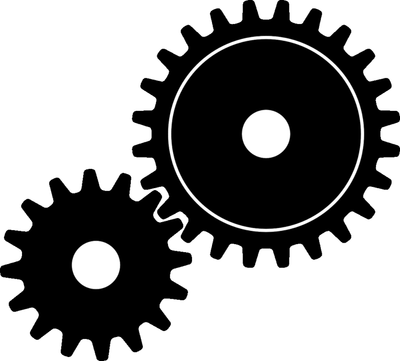Difference between revisions of "Gear"
| Line 27: | Line 27: | ||
===About Gears=== | ===About Gears=== | ||
| − | : The multiplying effect of [[gear]]s can be found by the [[ratio]] of the | + | : The multiplying effect of [[gear]]s can be found by the [[ratio]] of the radii or the number of 'teeth'. |
: A [[gear]] with few teeth turning a [[gear]] with many teeth acts to decrease the [[speed]] and increase the [[moment]]. | : A [[gear]] with few teeth turning a [[gear]] with many teeth acts to decrease the [[speed]] and increase the [[moment]]. | ||
: A [[gear]] with many teeth turning a [[gear]] few teeth acts to increase the [[speed]] and decrease the [[moment]]. | : A [[gear]] with many teeth turning a [[gear]] few teeth acts to increase the [[speed]] and decrease the [[moment]]. | ||
| Line 34: | Line 34: | ||
===Example Calculations=== | ===Example Calculations=== | ||
{| class="wikitable" | {| class="wikitable" | ||
| − | | style="height:20px; width:200px; text-align:center;" |A [[gear]] with | + | | style="height:20px; width:200px; text-align:center;" |A [[gear]] with radius 50mm is turned with a [[moment]] of 10Nm. This [[gear]] used to turn a second [[gear]] with a radius of 20mm. Calculate the [[moment]] of the second [[gear]]. |
| style="height:20px; width:200px; text-align:center;" |A [[gear]] with 45 teeth is turned with a [[moment]] of 25Nm. This [[gear]] used to turn a second [[gear]] with a 63 teeth. Calculate the [[moment]] of the second [[gear]]. | | style="height:20px; width:200px; text-align:center;" |A [[gear]] with 45 teeth is turned with a [[moment]] of 25Nm. This [[gear]] used to turn a second [[gear]] with a 63 teeth. Calculate the [[moment]] of the second [[gear]]. | ||
| style="height:20px; width:200px; text-align:center;" |A [[gear]] with 144 teeth is turned with a [[moment]] of 72Nm. This [[gear]] used to turn a second [[gear]] with 60 teeth. Calculate the [[moment]] of the second [[gear]]. | | style="height:20px; width:200px; text-align:center;" |A [[gear]] with 144 teeth is turned with a [[moment]] of 72Nm. This [[gear]] used to turn a second [[gear]] with 60 teeth. Calculate the [[moment]] of the second [[gear]]. | ||
Revision as of 20:25, 7 April 2019
Contents
Key Stage 2
Meaning
Gears are circular disks with 'teeth' that lock together with other gears to change how quickly they spin.
About Gears
- Gears are used in bikes, cars, and any engine which turns.
| The speed can be made bigger by turning the larger gear. The small gear will turn more quickly. |
Key Stage 3
Meaning
Gears are circular disks with 'teeth' that can act to increase the speed or the moment of a force.
About Gears
- A small gear turning a large gear acts to decrease the speed and increase the moment.
- A large gear turning a small gear acts to increase the speed and decrease the moment.
Key Stage 4
Meaning
Gears are circular disks with 'teeth' that can act to increase the speed or the moment of a force.
About Gears
- The multiplying effect of gears can be found by the ratio of the radii or the number of 'teeth'.
- A gear with few teeth turning a gear with many teeth acts to decrease the speed and increase the moment.
- A gear with many teeth turning a gear few teeth acts to increase the speed and decrease the moment.
- The force on one gear is equal in magnitude to the force applied to the other gear.
Example Calculations
| A gear with radius 50mm is turned with a moment of 10Nm. This gear used to turn a second gear with a radius of 20mm. Calculate the moment of the second gear. | A gear with 45 teeth is turned with a moment of 25Nm. This gear used to turn a second gear with a 63 teeth. Calculate the moment of the second gear. | A gear with 144 teeth is turned with a moment of 72Nm. This gear used to turn a second gear with 60 teeth. Calculate the moment of the second gear. |
| 1. State the known quantities
Moment = 10N Radius 1 = 50mm = 0.05m Radius 2 = 20mm = 0.02m |
1. State the known quantities
Moment = 25Nm Teeth Ratio = 45:63 |
1. State the known quantities
Moment = 70Nm Teeth Ratio = 144:60 |
| 2. Substitute the numbers into the equation and solve.
\(M = Fd\) \( 10 = F \times 0.05\) \( F = 200N\) An equal force applies to the second gear. \( M = F \times d\) \( M = 200 \times 0.02\) \( M = 4Nm\) |
2. Substitute the numbers into the equation and solve.
\( M = \frac {25}{45} \times 63\) \( M = 35Nm\) |
2. Substitute the numbers into the equation and solve.
\( M = \frac {72}{144} \times 60\) \( M = 30Nm\) |

